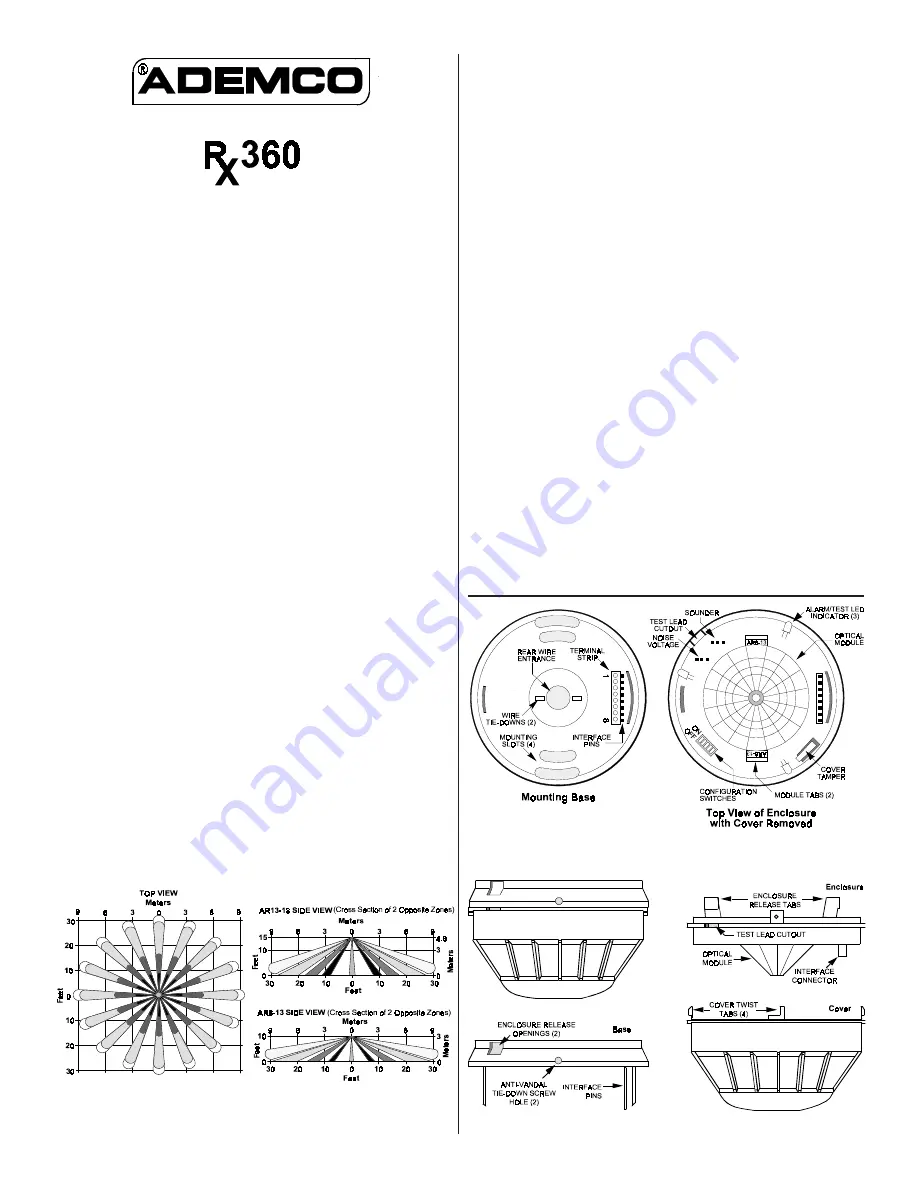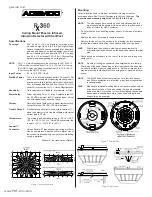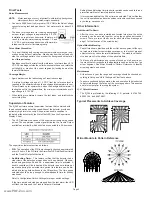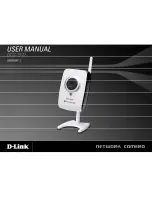
Ceiling Mount Passive Infrared
Intrusion Detector with Self-Test
Specifications
Coverage:
360° by 60 ft. (18.3 m) diameter coverage when
mounted on eight to 18 ft. (2.4 to 5.5 m) high ceilings.
Pattern consists of 64 zones grouped into 16 barriers,
with one additional zone looking straight down from
the unit (sabotage). Each barrier is 30 ft. (9.2 m) long
and 4.4 ft. (1.3 m) wide at 30 ft. (9.2 m). Choice of two
optical modules depending on ceiling height.
NOTE:
For U. L. Listed Requirements, the coverage is 360° by 54 ft.
(16.5 m) when mounted from 10 to 13 ft. (3.1 to 4.0 m) using
the AR8-13 Array and when mounted from 15 to 18 ft. (4.6 to
5.5 m) using the AR13-18 Array.
Input Power:
6.0 to 15.0 VDC; 18 mA.
Standby Power:
There is no internal standby battery. Connect to DC
power sources capable of supplying standby power if
primary power fails. Eighteen mA-H required for each
hour of standby time needed.
Four hours (72 mA-H
minimum) are required for U. L. Listed Requirements.
Sensitivity:
Field selectable for Standard, Intermediate, or High.
Alarm Relay:
Silent operating Form “C” relay. Contacts rated 125
mA, 28 VDC maximum for DC resistive loads.
Do not
use with capacitive or inductive loads.
Tamper:
Normally Closed (with cover in place) tamper switch.
Contacts rated at 28 VDC, 125 mA maximum.
Trouble Output:
A solid state open collector conducts to terminal 1 (-)
when the detector is in a trouble condition. Maximum
current load is 25 mA.
Temperature:
The storage and operating range is -20° to +120°F
(-29° to +50°C).
For U. L. Listed Requirements, the
range is +32° to +120°F (0° to +50°C).
Sonalert™
Connector:
Using a Sonalert™ type sounder (low voltage) will pro-
vide an audible tone when the unit is in alarm.
Use of
the sounder is intended only as an aid for walk testing
during installation.
Sonalert™ is a trademark of Mallory.
Figure 1. Coverage Pattern
Mounting
Select a location likely to intercept an intruder moving
across the
coverage pattern. See
Typical Placements to Achieve Coverage. The
recommended mounting height is 8 to 18 ft. (2.4 to 5.5 m).
NOTE:
The mounting surface should be solid and vibration free (e.g.,
drop tiles should be secured if the area above the tiles is used
as an air return for HVAC systems).
•
Do not mount near air handling system outlets, or in areas of extreme
drafts.
•
Remove the cover by turning it counterclockwise.
•
Remove the base from the enclosure by pressing the two enclosure
release tabs inward while lifting the enclosure away from the base.
HINT:
Slightly rock the enclosure side-to-side during removal to
overcome the friction caused by the base-to-enclosure terminal
pins.
•
Route wiring as necessary to the rear of the base and through the
center hole.
NOTE:
Be sure all wiring is unpowered (de-energized) before routing.
•
Firmly mount the base. Depending on local regulations, the base may
be directly surface mounted using anchors, mollies, or wing-nuts, or
may be mounted to standard four-inch octagonal or square electrical
boxes.
NOTE:
The R
X
360 base will not completely cover a four-inch square
box. Where aesthetics are important, a four-inch octagonal box
is recommended.
HINT:
Mounting to removable ceiling tiles is not recommended unless
a sandwich is made of the base, ceiling tile, and a back plate
behind the tile. Covers used for four-inch octagonal and square
boxes make a suitable back plate (when used with bolts and
wing nuts, as an example).
Figure 2. Internal View
Figure 3. Enclosure
R
X
360-INST 12/97
www.PDF-Zoo.com






















